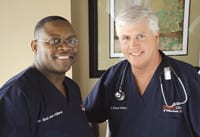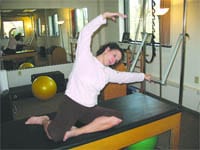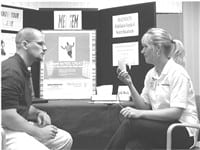When It’s Not an Emergency Urgent Care of Wilbraham Meets a Growing Need in Medicine
Dr. Richard Freniere and Dr. Rock Jean-Guillaume have spent their careers in emergency medicine. So they know a little something about what constitutes a real emergency.
“We’re familiar with all types of patients,” said Freniere, president of Emergency Services at Wing Memorial Hospital. “Many times, patients come into the emergency room with what are not true emergencies, and they end up waiting extended periods of time for care that can be provided under a different scenario.”
With that in mind, Freniere partnered with Jean-Guillaume, director of Wing’s Emergency Department, to launch Urgent Care of Wilbraham on Boston Road, the latest in a growing number of urgent-care practices opening their doors up across Western Mass.
“We’re open seven days a week,” Freniere said of the office, which opened in February. “We essentially provide care for almost every condition except true emergencies. Being emergency physicians, we’re comfortable with all of it — orthopedic injuries, lacerations, all kinds of infections, minor trauma, illnesses, they’re all within our wheelhouse. Things we don’t want to do are chest pains, strokes, complicated abdominal pain that requires extensive testing.”
The owners say Urgent Care of Wilbraham isn’t an ER, and it isn’t primary care, but a place to get help for situations that don’t rise to the level of emergencies, and when a primary-care physician (PCP) isn’t available.
“We get a lot of seasonal things — seasonal allergies, sinusitis, poison ivy,” Jean-Guillaume said. “But year-round, we see a lot of lacerations, a lot of general, non-emergency things. And sometimes we see things that are emergencies, and we have to decide if this is benign or something that needs immediate evaluation. We’ve had some ambulance transfers from here as well.”
Therein lies the difference between their practice and many other urgent-care sites that are staffed by general-practice doctors. The fact that every physician on site is emergency trained brings a level of efficiency to the triage and treatment of patients. At the same time, the emergency expertise on site means an ability to treat more acute patients than other urgent cares.
“Sometimes we get referrals from other urgent-care centers — I got one, where, because of the complexity of the laceration, they didn’t feel comfortable with it,” Jean-Guillaume told HCN. “We try to see everyone. We know how important it is to the community and to surrounding communities.”
Freniere agreed that their experience treating more serious injuries is a definite benefit to patients.
“No one comes in here where we don’t know what needs to be done. Sometimes we send you to other places, but most times we can handle it,” he said, adding that his team is trained to meet the immediate need, not give a full workup as a PCP might. “We treat your immediate problem. Primary-care doctors tend to look at all your problems, which makes the experience a lot longer. We don’t look at you that way. We don’t want to be your primary-care doctor.”
Added Jean-Guillaume, “we’ve been asked many times, ‘can you be my doctor?’ But we say ‘no … you need a primary-care doctor.’”
Meeting a Need
In addition to his ED experience, Freniere operated an urgent-care facility in Fitchburg for many years, and recognized the Pioneer Valley as fertile ground for such an enterprise. With Palmer-based Wing Memorial operating satellite facilities in Ludlow, Belchertown, and Monson, Route 20 in Wilbraham seemed like an ideal location.
“I partnered with Rock, and we have an agreement with Wing to provide X-ray services and laboratory services,” he explained. “We felt like this community could use an urgent care, so we started in February.
“We want to provide care in a little more upscale scenario, so we had this place constructed,” he added while showing HCN around the practice, with its four exam rooms and homey, earth-toned décor. “It’s nicer than most people think a physician’s office or medical setting should be. The reviews we’ve gotten back so far are great — ‘who’d you use to decorate?’ We wanted it to be relaxed.”
For the patients, that is. For the staff — which always includes a physician, a diagnostic technician, one or two medical assistants, and various office staff — it’s all about providing quality care with the precision of a well-run ER. Part of the credit goes to site administrator Jay Adams, a registered nurse with plenty of background in information technology and medical administration.
“He’s able to provide all those services in one person,” Freniere said. “Jay can fill in clinically as well as administratively.”
Adams said all employees, not just the ownership, “take a vested interest in the success of our operation. This is very different from where I’ve worked in the past.”
He added that he sees huge potential for growth, noting that urgent care has caught on more rapidly elsewhere. “In other parts of the country, you see urgent care everywhere. Regionally, it seems we’re finally catching up.”
Jean-Guillaume agreed. “It is a growing field, particularly with changes in the medical climate and Obamacare,” he said, adding that as healthcare continues to shift toward accountable care, with its emphasis on reducing costs and keeping people out of hospitals, that growth will only continue.
“One of the advantages is keeping patients out of emergency departments and out of hospitals,” he said, adding that “I wouldn’t be surprised if we didn’t see a lot of post-discharge facilities popping up next, with the mandates not to re-hospitalize people within 30 days. That’s the model of the future.”
It’s a model being increasingly recognized by insurers, Adams noted; Urgent Care of Wilbraham currently contracts with 17 different payers.
“Blue Cross in particular will guide its patients to the nearest urgent care,” Freniere said. “It makes sense economically for the carrier as well as the patient. Blue Cross Blue Shield doesn’t want to send $600 to the ER for an earache when they could spend $30, and the consumer who has a deductible is thrilled to pay a $20 co-pay as opposed to $200.”
Referrals actually arrive from many sources, nor just payers, he added. Area doctors will direct patients there if they’re booked solid, and newspaper advertising has helped bring awareness as well. “But one of the biggest ones is word of mouth. One person is happy, and the next thing you know, they talk to several people. That’s been huge. Within four months, we’ve hit our targets, our daily goals, which is impressive.”
Rapid Response
Jean-Guillaume, who did a lot of urgent-care work after earning his medical degree and believes in the concept, says he’s gratified to be part of a fast-paced practice that doesn’t necessarily see the “big, bad stuff” he encounters in the ER.
“We knew the community needed a rapid-care [practice], so we found what we think is an ideal spot. Right now, it seems like the decision was sound. People appreciate what we provide for the community. We’ve had several people come back because they appreciate our services. We always emphasize that patients should have a primary-care physician, but we manage them until they can see a primary-care physician.”
“The bottom line,” Freniere stressed, “is that, if you can’t get in to see your primary-care physician, or it’s after hours or an acute kind of condition, that’s what we’re here for. For the management of your chronic blood pressure … well, that’s not us.”
Both doctors have sacrificed much free time — they’re still major players in Wing’s Emergency Department, after all — to launch a practice they feel is increasingly necessary in today’s healthcare economy.
“This is a new business, and I’ve kind of given up my personal life to make sure this works,” Jean-Guillaume told HCN. “It’s a pleasure to be here. Even when it gets busy, you’re the owner, and you know you’re providing great care and comfort for patients. It’s just good people doing a good job.”



